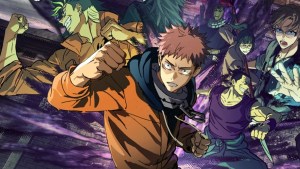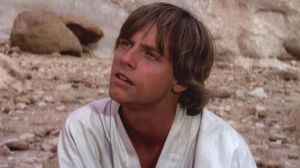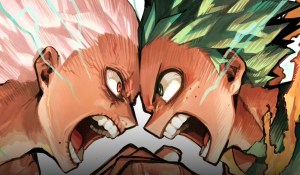No, not the Boom! imprint. We’re talking the Awesome Universe today….
Videos by ComicBook.com
Welcome to another edition of “Augie Is Cleaning Up Some Comics and You’ll Never Believe What He Found in the Back of a Longbox THIS Time!”
Things Go KABOOM

In 1997, Rob Liefeld’s Awesome Entertainment company published three issues of “KABOOM,” a mini-series about a 16 year old boy who suddenly discovers his destiny to wear super powered gloves and beat back weird creatures from another realm. Also, his family has all sorts of secrets that will be revealed to him only when the time is right — like as issue-ending cliffhangers.
Written by Jeph Loeb, it bears all the hallmarks of his style. Comicraft provides the usual colored caption boxes to show us the characters’ thoughts. Dialogue is clipped and speedy. Loeb doesn’t like to bore you with exposition and run-on sentences. Or maybe this is his Hollywood experience in writing compact scripts showing. Either way, there it is.
Jeff Matsuda handles the art chores, with inks from Liefeld studios regular, Jon Sibal. Matsuda’s work is young here and still developing, but is leagues ahead of what he did on “NewMen” a couple years earlier.
Even in “KABOOM,” though, he was a better character designer than panel to panel storyteller. There’s a lot of panel mish-mash going on in this book, and extreme angles chosen because they looked cool more than that they told the story well.
There’s also a lot of sizzle added on top of the art to distract from that. There’s a lot of speedlines and glowing force lines that zig zag around pages. Those force lines are a well designed element on top of the page, but often makes pages look busy.
Combined with pages that are mostly overlapping panels, often at odd angles and seemingly random locations on the page, it’s not always the easiest book to follow. Dave Lanphear at Comicraft does the best he can with what he has to work with to arrange the word balloons and caption boxes to best guide your eye through these panels.

Matsuda’s art style is great. It’s a very anime inspired cartoony looking thing that was growing in popularity in the mid-90s. It’s perfect for a book starring younger characters surrounded by demons or other flights of fantasy and imagination.
You could compare it to Joe Madureira, though a bit more angular. The first issue is likely the highlight of the series, as it begins with Geof Sunrise (who is Kaboom) fighting off a group of nine villains with his new power gloves locked and loaded.
The villains are a diverse group of monster-like characters, from the two small demons who look either like Olympic Mascots, or rejected designs from Pixar’s “Inside Out”. They have odd sets of powers and physical exteriors.
They’re also very toyetic.
This could be the cast for a Kaboom animated series, and I’d be shocked if one wasn’t being pitched around town back in 1997 when this series first saw print. The book is owned by Awesome, so I have no doubt that part of the business plan was to shop this around Hollywood as quickly as possible.
Matsuda left the comics world to go into animation, so it’s not that big a stretch…
The Story

Geof is thrown into this world. He’s not sure he wants to be a part of it. He wants to be a normal kid and he wants the cute girl he’ll never have, often at the expense of the cute girl next door who is already his best friend and very jealous.
But then he has these cool powers and it turns out he’s a bit of the Chosen One and bad guys with more power are coming after him because of it. He can’t run away.
It’s elements of The Flash and his Speed Force mixed with Spider-Man’s personal life.

It’s a roller coaster ride more than anything. It’s not terribly deep. It’s all a shallow series of fight sequences with some personal backgrounds trying to tie it together. I find myself not caring enough. There’s no time to think and no real attempt at a mystery here. It feels like things have to be handed to you on a silver platter just before they happen or as they are happening.
It’s worth taking a look at for some of Matsuda’s art and design. The storytelling has some strong moments, but a lot of fight scenes are trying too hard to feel like the chaos of a fight scene with the random jagged orientation of panels. (The few quieter moments in the book have more reserved grids of panels.)
And don’t forget the colors from Steve Buccellato. They’re great for Matsuda’s art. They remind me of the style Christian Lichtner was using over Joe Madureira on “Uncanny X-Men” at the time — bright bold colors, with shiny highlights on raised areas. It’s a good slick look for this book.
The Sequel
A second mini-series debuted a couple years later, but with some major changes. The story was set a couple years later, though Geof had visibly aged much more. The story centered on a new young chosen one, Kyra, who Geof and Zang (his trainer in all things Kaboom) would have to train in the ways of the Kaboom Force. Geof’s friend who is a girl, Kate, is completely out of the book and not even mentioned. His father is also absent.
Keron Grant was the new penciler, and the book was shot straight from him pencils, which worked OK. Grant showed very dynamic art, with a wealth of angles to work from, and some very elongated characters as part of his style.
The series wrapped up in another three issue arc, once again ending with a cliffhanger about a member of Geof’s family. It’s his mother this time.
That’s all she wrote for “Kaboom,” so don’t expect to learn more about Geof’s family, who always pop up unexpectedly to tease something major out of left field to get you to buy the next issue.
There is no next issue. The first three issues were collected into a trade nearly ten years ago now, and that’s long of out print. Nor is the book available digitally. Someday, maybe…
PipelineComics.com|| Twitter || Instagram || E-mail || YouTube








